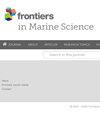Variability of plankton communities in relation to the lunar cycle in oceanic waters
IF 2.8
2区 生物学
Q1 MARINE & FRESHWATER BIOLOGY
引用次数: 0
Abstract
The short-term variability of plankton communities in the oceanic realm is still poorly known due to the paucity of high-resolution time-series in the open ocean. Among these few studies, there is compelling evidence of a lunar cycle of epipelagic zooplankton biomass in subtropical waters during the late winter bloom. However, there is few information about lower trophic levels and zooplankton physiological changes related to this lunar cycle. Here, we studied the short-term variability of pico-, nano-, micro-, and mesoplankton in relation to the lunar cycle in subtropical waters. Weekly sampling was carried out at four stations located north of the Canary Islands from November 2010 to June 2011. Zooplankton abundance and biomass, gut fluorescence (GF), electron transfer system (ETS), and aminoacyl-tRNA synthetase (AARS) activities were measured before, during, and after the winter vertical mixing in these waters in a wide range of size classes. Chlorophyll求助全文
约1分钟内获得全文
求助全文
来源期刊

Frontiers in Marine Science
Agricultural and Biological Sciences-Aquatic Science
CiteScore
5.10
自引率
16.20%
发文量
2443
审稿时长
14 weeks
期刊介绍:
Frontiers in Marine Science publishes rigorously peer-reviewed research that advances our understanding of all aspects of the environment, biology, ecosystem functioning and human interactions with the oceans. Field Chief Editor Carlos M. Duarte at King Abdullah University of Science and Technology Thuwal is supported by an outstanding Editorial Board of international researchers. This multidisciplinary open-access journal is at the forefront of disseminating and communicating scientific knowledge and impactful discoveries to researchers, academics, policy makers and the public worldwide.
With the human population predicted to reach 9 billion people by 2050, it is clear that traditional land resources will not suffice to meet the demand for food or energy, required to support high-quality livelihoods. As a result, the oceans are emerging as a source of untapped assets, with new innovative industries, such as aquaculture, marine biotechnology, marine energy and deep-sea mining growing rapidly under a new era characterized by rapid growth of a blue, ocean-based economy. The sustainability of the blue economy is closely dependent on our knowledge about how to mitigate the impacts of the multiple pressures on the ocean ecosystem associated with the increased scale and diversification of industry operations in the ocean and global human pressures on the environment. Therefore, Frontiers in Marine Science particularly welcomes the communication of research outcomes addressing ocean-based solutions for the emerging challenges, including improved forecasting and observational capacities, understanding biodiversity and ecosystem problems, locally and globally, effective management strategies to maintain ocean health, and an improved capacity to sustainably derive resources from the oceans.
 求助内容:
求助内容: 应助结果提醒方式:
应助结果提醒方式:


